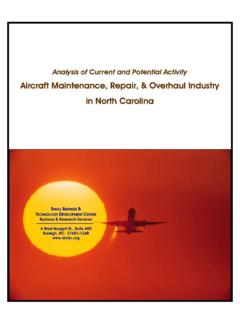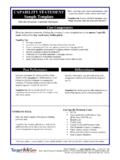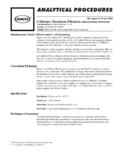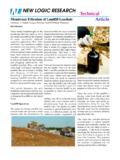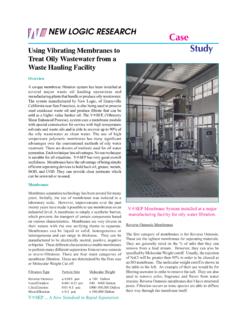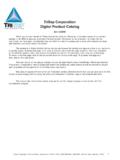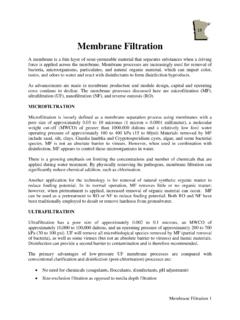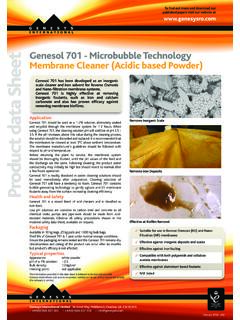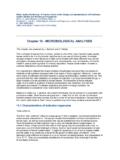Transcription of USDA Sample Proposal - NC SBTDC
1 usda Sample Proposal membrane -Based Process for Debittering Citrus Juice (Figures and Tables are Unavailable on this Website.) I IDENTIFICATION AND SIGNIFICANCE OF THE PROBLEM Citriculture is an important segment of world food production and nutrition. Oranges account for 67% of total worldwide citrus production. Oranges are consumed, principally in the form of juice, at an annual rate of approximately 17 kilograms per person (The Almanac of the Canning, 1979). A major problem in the citrus industry worldwide is the formation of bitterness in citrus juice and products within hours after extraction from the fruit. The problem occurs in certain varieties of oranges (including mandarins), grapefruits, and lemons.
2 The problem is estimated to cause losses for California citriculture of $6 million to $8 million per year (anon., 1986a). The primary cause of the delayed bitterness in oranges is the presence of an intensely bitter group of compounds called limonoids, principally limonin and nomilin (Figure 1). The extent of bitterness imparted by limonin has been studied by Levi and coworkers (Levi et al., 1974), who obtained the values shown in Table I. Much research has been focused on preventing the formation of limonin precursors prior to harvest, as well as on finding means to remove limonin after harvesting and processing. An excellent review of the approaches is given by Hasegawa and Maier (Hasegawa and Maier, 1983), and a summary of recent R&D activities is given in Section of this Proposal .
3 However, existing methods have severe economic and technical limitations (Anon., 1985). Additionally, existing methods often impair the stability and quality of the juice by affecting components other than limonin. Thus, despite extensive research efforts, there is no acceptable commercial method for reducing levels of bitter citrus components. The only current option is to blend excessively bitter juice with non-bitter juice. The proposed program is directed at demonstrating the feasibility of using a novel process for the removal of loimonin and nomilin from bitter navel orange juice. The process is based on a membrane that selectively allows the passage of limonin, limonoic acid, nomilin, and nomiloic acid, while retaining desirable flavor and nutritional components.
4 The proposed process is designed so that the juice or concentrate contacts only materials that are accepted for food use or have been shown to be generally recognized as safe. Furthermore, the proposed process promises to be economical on the basis of our preliminary analysis, as is discussed in Section II BACKGROUND, TECHNICAL APPROACH AND ANTICIPATED BENEFITS SOLUTION-DIFFUSION MEMBRANES OFFER A MEANS TO DEBITTER ORANGE JUICE An attractive approach to the removal of off-flavors (a solute) in fruit juices involves the use of a synthetic membrane that allows the off-flavor to pass through but retains the desired components in the juice. Membranes can be conveniently categorized into two groups (Figure 2): 1) filtration membranes, and 2) solution-diffusion membranes.
5 The more conventional filtration membranes have been studied extensively for food-processing applications, and their limitations are well known. Those limitations include severe problems with membrane fouling in the application of interest here (Matthiasson, E., 1985). Solution-diffusion membranes, on the other hand, show substantial promise in this type of application. Filtration membranes contain pores. When a solution is forced through a filtration membrane (convective flow), solute molecules smaller than the pores pass easily; solute molecules larger than the pores are retained. Consequently, the selectivity of this type of membrane is dictated by molecular size. Moreover, a phenomenon known as concentration polarization , the buildup o solutes on the membrane surfaced leads to membrane fouling and drastically reduced performance.
6 Solution-diffusion membranes do not have pores, and thus there is no convective flow through the membrane . Instead, solute molecules dissolve in the membrane phase and permeate the membrane by molecular diffusion. Molecular solutes that exhibit high solubilities and/or diffusivities in the membrane phase and/or that have low diffusivities are retained. Thus, the selectivity in this type of membrane is closely correlated with solute solubility, and an analysis of this type of membrane parallels liquid-liquid extraction rather than filtration. The key distinction is that, relative to filtration membrane processes, solution-diffusion membrane processes exhibit minimal concentration polarization and consequently resist fouling.
7 This is because solute transport occurs via dissolution in the membrane phase, rather than by convective flow through pores. In our proposed process, we will use solution-diffusion membranes. Specifically, the membrane consists of a thin layer of a hydrophobic liquid, about 25 um thick, that separates two aqueous solutions. The hydrophobic liquid is supported and stabilized within the pores of a microporous, hydrophobic polymer film. Such supported-liquid membranes have been shown in our laboratory to be stable for up to a year, even when separating aqueous solutions that have acid concentrations that differ by ten or more pH unites. That degree of chemical stability is critical in the proposed application.
8 The operation of this type of membrane for the removal of limonin and limonoic acid (*Because the solubility and chemical properties of limonin and nomilin are extremely similar, we believe that the membrane process will operate equally well for nomilin and nomiloic acid. We will therefore use limonin and limonoic acid as generic terms for all four types of liminoids of interest here.) is illustrated in Figure 3. A feed solution containing orange juice at pH flows on the left side of the membrane , and a stripping solution containing aqueous sodium hydroxide at pH 12 to 13 flows on the right side. Limonin from the feed solution dissolves in the hydrophobic supported liquid of the membrane and is transported across the membrane to the strip side by diffusion.
9 Limonoic acid, produced by the hydrolysis of limonin, is also present in the feed solution. Since the pKa s of limonoic acid are and , at a pH of the pH of the juice one carboxyl group of limonoic acid and a significant fraction of the other carboxyl group are protonated. Thus, limonoic acid, bearing no charges, also dissolves in the hydrophobic supported liquid of the membrane and is transported to the strip side. At the membrane /strip-side solution interface, limonin and limonoic acid dissolve in the strip solution and are rapidly and irreversibly hydrolyzed and deprotonated to limonate under the basic conditions of the strip solution. Since anionic limonate, bearing charges, is insoluble in the supported liquid of the membrane , it cannot back-diffuse therefore, limonin and limonoic acid are irreversibly transported from the feed solution to the strip solution.
10 Because limonate is confined to the strip stream, it can be concentrated by using a strip-stream volume that is smaller than the feed-stream volume that. The strip-stream volume is reduced by setting the strip-stream flow rate lower than the feed-stream flow rate. From material balance considerations, Limonin Conc in Strip Stream = Limonin Conc. In Feed Stream x (Feed- Stream Flow Rate/ Strip-Stream Flow Rate) Hence, the proposed supported-liquid membrane process makes possible the removal and concentration of limonin from orange juice. PRELIMINARY EXPERIMENTS SUPPORT THE PRPOSED APPROACH We have conducted preliminary experiments that indicate that the proposed supported-liquid membrane process efficiently transports limonin and lmonoic acid.

